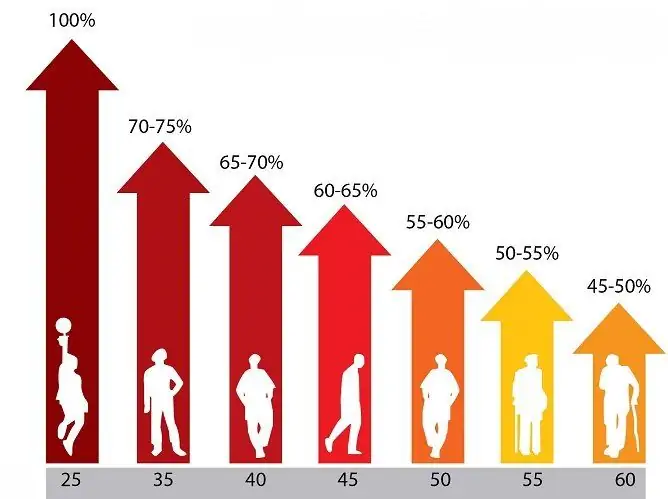- Author Rachel Wainwright [email protected].
- Public 2023-12-15 07:39.
- Last modified 2025-11-02 20:14.
What is pulse pressure?
The content of the article:
- What PD can tell
- Normal, low and high PD
- How to determine PD
- What to do with high and low PD
Pulse pressure is the difference between two indicators obtained when measuring blood pressure by the Korotkov method, that is, between systolic (upper) and diastolic (lower) pressure. Pulse pressure reflects the state of the cardiovascular system and is an important diagnostic criterion for many pathologies.

PD is easy to calculate by knowing the systolic and diastolic pressure
Blood (arterial) pressure (BP) is usually written in the form of two numbers, separated by a fraction. The maximum reading is recorded first (the denominator of the fraction), this is the systolic pressure. It shows with what force the blood presses on the walls of blood vessels at the time of contraction of the heart (systole). The minimum indicator is called diastolic, it characterizes the total resistance of the blood vessels. The difference between the two, expressed in millimeters of mercury. Art. (written as mmHg) is called pulse pressure (PP).
What PD can tell
At the moment of contraction, the heart pushes a certain volume of blood (stroke volume) into the vascular system, which causes the blood vessels to stretch. During diastole, the vessels, due to the elasticity of their walls, return to their original volume. Under the influence of certain diseases, as well as age-related changes, human vessels lose their natural elasticity and firmness. As a result, they become rigid and unable to adequately respond to the pulse wave, which leads to an increase in AP.
The doctor judges the state of the vascular walls, the patency of the vessels, the presence of vascular spasm by the value of the PD.
Normal, low and high PD
Normal pulse pressure is between 30 and 50 mm Hg. Art., since the diastolic pressure should not be less than 25% of the systolic pressure.
The rate may vary depending on the age group. Age differences in PD are presented in the table of pulse pressure norms by age.
| Age | BP (mmHg) | PD (mmHg) |
| First month of life | 60-80 / 40-50 | 20-30 |
| 1 to 12 months | 100 / 50-60 | 40-50 |
| 1 to 6 years old | 100-110 / 60-70 | 30-40 |
| 6-10 years old | 110-120 / 60-80 | 40-50 |
| 10 to 15 years old | 110-120 / 70-80 | 30-50 |
| 15 to 50 years old | 110-140 / 70-90 | 30-50 |
| 50 to 60 years old | 130/80 | 50 |
| 60 to 80 years old | 140-150 / 80-90 | 50-60 |
Low (less than 30 mm Hg) PD, always indicates the pathology of the cardiovascular system. Most often these are the following conditions:
- myocardial infarction;
- cardiosclerosis;
- heart failure;
- massive blood loss.
An increased PD is considered an even more dangerous condition than a decreased one. This is due to the fact that the higher it is, the more stress the heart works. A PD exceeding 60-70 mm Hg is especially dangerous. Art., since in this case hypoxia of the internal organs and the brain develops and rapidly increases.
The reason for the increase in PD can be:
- atherosclerosis;
- chronic cardiovascular failure;
- chronic respiratory failure;
- acute and chronic renal failure;
- endocarditis;
- valve regurgitation;
- heart block;
- severe anemia;
- feverish conditions;
- thyrotoxicosis.
PD over 80 mm Hg. Art. in combination with a violation of the rhythm of breathing and bradycardia is observed in patients with increasing intracranial hypertension.
High PD can also be observed in healthy adults, especially men, with significant physical activity. A decrease in PD to normal in this case occurs within 10-15 minutes of being at rest.
Is high PD dangerous? The answer to this question is provided by the analysis of medical statistics data. According to him, the risk of sudden death of patients is the higher, the higher this indicator is. At present, the relationship between diseases of the cardiovascular system and high PD has not been fully studied. It is suggested that this relationship is based on the high rigidity of the arterial tree, most often due to atherosclerotic processes.
How to determine PD
It is often mistakenly believed that in order to determine PD, it is necessary to count the pulse (it is more convenient to do this with a heart rate monitor), but in fact, PD and heart rate are completely different indicators.

Determining pulse pressure and measuring pulse are not the same, they are different indicators
To determine the PD, first of all, it is necessary to measure blood pressure. Then make a calculation using the formula: PD = SD - DD, where:
- SD - systolic pressure;
- DD is diastolic pressure.
For example, a patient's blood pressure is 100/60 mm Hg. Art. Accordingly, the PD will in this case be equal to 40 mm Hg. Art. (100 - 60 = 40).
What to do with high and low PD
It should be understood that increased or decreased PD is just a symptom, and not an independent disease. Therefore, treatment should be aimed at correcting the underlying pathology:
- with hypovolemia - replenishment of the circulating blood volume (crystalloid and colloidal solutions, blood plasma, erythrocyte mass);
- with cardiogenic shock - adequate pain relief, therapy aimed at improving myocardial contractility;
- with renal ischemia - anti-inflammatory and vasodilator drugs, antiplatelet agents;
- in chronic heart failure - therapy with cardiac glycosides and diuretics;
- with vascular spasm - ACE inhibitors, myotropic antispasmodics, calcium antagonists.
Indications for surgical treatment are congenital or acquired heart defects, pathology of the aortic valves. After surgery, the patient's hemodynamics improves and PD normalizes.
Video
We offer for viewing a video on the topic of the article.

Elena Minkina Doctor anesthesiologist-resuscitator About the author
Education: graduated from the Tashkent State Medical Institute, specializing in general medicine in 1991. Repeatedly passed refresher courses.
Work experience: anesthesiologist-resuscitator of the city maternity complex, resuscitator of the hemodialysis department.
Found a mistake in the text? Select it and press Ctrl + Enter.






